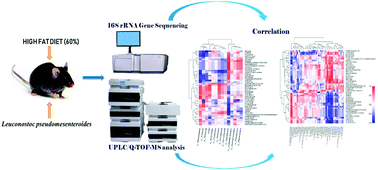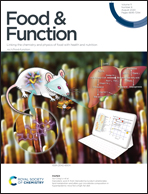Leuconostoc pseudomesenteroides improves microbiota dysbiosis and liver metabolism imbalance and ameliorates the correlation between dihydroceramide and strains of Firmicutes and Proteobacteria in high fat diet obese mice†
Abstract
Leuconostoc pseudomesenteroides is widely isolated from fermented foods; however, the underlying molecular mechanism behind its anti-obesity function has rarely been studied. This study aims to explore the role of alterations in gut microbes and liver metabolites mediated by Leuconostoc pseudomesenteroides (Tu) in obese mice for a period of 8 weeks through UPLC/Q-TOF-MS and 16S rRNA sequencing. Our results showed that Tu administration at a dosage of 1 × 109 CFU per day per mouse effectively attenuated the weight of mice, significantly reduced serum lipids, and markedly improved fecal lipid output. Tu also ameliorated the lipid profiles in the liver and epididymal fat tissues, and restored intestinal disorder caused by a high-fat diet. Moreover, glycerophospholipid metabolism in the liver was altered by increased dihydroceramide levels. Surprisingly, the correlation between dihydroceramide and strains of Firmicutes and Proteobacteria was found for the first time. Collectively, these findings highlight that Tu could be a potential dietary supplement for weight control.



 Please wait while we load your content...
Please wait while we load your content...